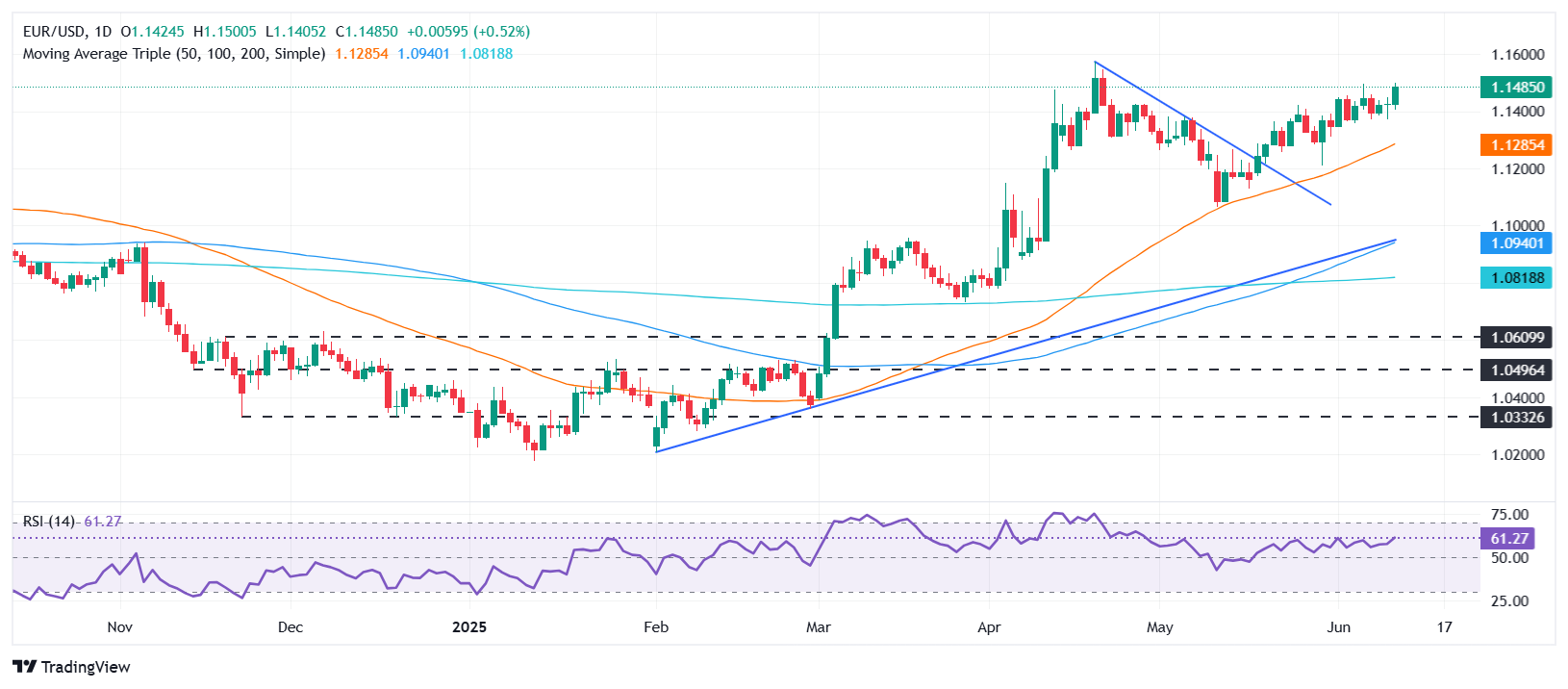- EUR/USD advances as the lowest inflation in the US generates calls to aggressive rate cuts by the Fed.
- Trump sets out to a cut of a percentage point in the FED fund rate after the CPI.
- Those responsible for the ECB policy are cautious, but inflation prospects suggest an additional adjustment.
The EUR/USD shot during the North American session, but still does not exceed 1,1500, after the publication of an inflation report in the United States (USA) softer than expected, which could lead to the Federal Reserve (Fed) to reduce the debt costs in the short term. At the time of writing, the PAR is quoted in 1,1482, with an increase of more than 0.50%.
The US data revealed that the Consumer Price Index (CPI) in May did not meet the estimates, since prices continued in downward trend. After the publication of the data, the US president, Donald Trump, published in his social network that the Fed should reduce the rate of federal funds by a complete percentage point.
Although inflation decreased, some analysts project homes will feel the impact of tariffs in next month. Meanwhile, positive commercial news about negotiations between the US and China emerged, since the Wall Street Journal (WSJ) revealed that China is imposing a six -month limit on the export licenses of rare earths for US manufacturers and motorists.
Meanwhile, in the Eurozone (EU), those responsible for the policy of the European Central Bank (ECB) made headlines, although they failed to move the Eur/USD pair. Vujcic of the ECB said that it seeks more clarity about trade, while Kazaks said that it is “quite likely that 2% inflation requires some additional cuts for fine adjustment,” he said through Econostream in X.
The ECB chief economist, Philip Lane, added that last week’s rate cut helped to clarify the bank’s policy position to bring inflation towards his goal.
In the coming week, the EUR/USD is expected to be very influenced by the publication of the US Production Price Index (IPP) index, together with the Initial Applications Report of unemployment subsidy. On the other side of the ocean, the EU agenda is scarce in economic data, but ECB officials, headed by Vice President Luis de Guindos, will be at the center of attention.
What moves the market today: the EUR/USD shoots above 1,1480 as the operators focus on the US PPI data.
- The EUR/USD seems to be prepared to prove the 1,1500 mark in the short term, since the positive news about the conversations between the US and China could increase the appetite for higher risk assets and weigh on the US dollar.
- The US Treasury Secretary, Scott Besent, commented that commercial equity with China could be achieved by reducing exports to the US or re -evaluating the world’s largest economies. He added that the Trump administration is committed to maintaining the reserve currency status of the US dollar.
- Inflation in the US was softer than expected in May. The general CPI rose 2.4% year -on -year, slightly above 2.3% in April, but below the 2.5% forecast. The underlying IPC remained stable at 2.8% year -on -year, suggesting that underlying inflation remains stable but persistent.
- It is projected that the May PPI increases from 2.4% to 2.6% year -on -year. The underlying figures of the PPI are expected to remain at 3.1% more, without changes compared to the April figure.
- Financial market participants do not expect the ECB to reduce their deposit installation rate at 25 basic points (PBS) at the July monetary policy meeting.
EURO TECHNICAL PERSPECTIVE: THE EUR/USD ALCISTAS SIGN TO 1.15 AND MAXIMUM OF THE YEAR
From a technical perspective, the upward trend is expected to continue as buyers sign up for a clear break above the 1,1500 figure. This will expose the maximum of the year to date (YTD) of 1,1572, before 1,1600. The relative force index (RSI) is bullish, indicating an ascending direction, suggesting that buyers are gaining impulse.
The least probable stage is that the EUR/USD needs to overcome the area of 1,1450. This would establish the torque for a setback to the simple mobile average (SMA) of 20 days in 1,1346 before trying 1,1300.

Euro Faqs
The euro is the currency of the 19 countries of the European Union that belong to the Eurozone. It is the second most negotiated currency in the world, behind the US dollar. In 2022, it represented 31 % of all foreign exchange transactions, with an average daily business volume of more than 2.2 billion dollars a day. The EUR/USD is the most negotiated currency pair in the world, with an estimate of 30 %of all transactions, followed by the EUR/JPY (4 %), the EUR/GBP (3 %) and the EUR/AU (2 %).
The European Central Bank (ECB), based in Frankfurt (Germany), is the Eurozone reserve bank. The ECB establishes interest rates and manages monetary policy. The main mandate of the ECB is to maintain price stability, which means controlling inflation or stimulating growth. Its main tool is the rise or decrease in interest rates. Relatively high interest rates (or the expectation of higher types) usually benefit the euro and vice versa. The GOVERNMENT BOOK of the ECB makes decisions about monetary policy in meetings that are held eight times a year. The decisions are made by the directors of the National Banks of the Eurozone and six permanent members, including the president of the ECB, Christine Lagarde.
Eurozone inflation data, measured by the harmonized consumer prices index (IPCA), are an important economic indicator for the euro. If inflation increases more than expected, especially if it exceeds 2% of the ECB, it forces the ECB to rise interest rates to control it again. Relatively high interest rates compared to their counterparts usually benefit the euro, since they make the region more attractive as a place for global investors to deposit their money.
Published data measure the health of the economy and can have an impact on the euro. Indicators such as GDP, manufacturing and services PMIs, employment and consumer trust surveys can influence the direction of the single currency. A strong economy is good for the euro. Not only attracts more foreign investment, but it can encourage the ECB to raise interest rates, which will directly strengthen the euro. Otherwise, if economic data is weak, the euro is likely to fall. The economic data of the four largest economies in the euro zone (Germany, France, Italy and Spain) are especially significant, since they represent 75% of the economy of the euro area.
Another important fact that is published on the euro is the commercial balance. This indicator measures the difference between what a country earns with its exports and what you spend on imports during a given period. If a country produces highly demanded export products, its currency will gain value simply by the additional demand created by foreign buyers seeking to buy those goods. Therefore, a positive net trade balance strengthens a currency and vice versa in the case of a negative balance
Source: Fx Street
I am Joshua Winder, a senior-level journalist and editor at World Stock Market. I specialize in covering news related to the stock market and economic trends. With more than 8 years of experience in this field, I have become an expert in financial reporting.





